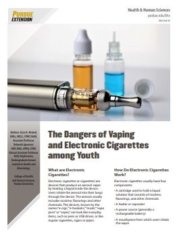A new generation is addicted to nicotine warns Purdue nursing faculty
“It was actually my daughter who first brought vaping to my attention,” Deborah Spoerner, clinical assistant professor in the School of Nursing in the College of Health and Human Sciences, said. “She came back home for a visit from college and said it seemed like everyone was vaping.”
This was several years ago. Now, of course, vaping and e-cigarette usage seems to make national headlines monthly. A November report from the Center for Disease Control and Prevention (CDC) recently shared some alarming news for Hoosiers- Indiana is leading the nation in deaths from vaping related illnesses. According to the CDC, 42 deaths across 24 states and the District of Columbia have occurred as a result of lung injuries from vaping, four of these in Indiana. The same report states that as of Nov. 2019, there were 2,172 confirmed lung injury cases associated with vaping. It is estimated that 5 million kids in middle and high school now vape or use e-cigarettes.
Many youths don’t actually know there is nicotine in the liquid used to vape, Spoerner explained, and while vaping can be damaging to anyone, teens are especially vulnerable when it comes to potential lung injury and cementing a long-term addiction. Nicotine, however, is far from the most potentially dangerous chemical in the blends. Diacetyl has been linked to lung injury, causing what is known as “popcorn lung,” a thickening and narrowing of the airways. In a report published by Environmental Health Perspectives, 51 liquids were tested for diacetyl and found in 39 of them. Vitamin E acetate, also found in many of the vaping liquids, has also been linked to lung injuries.

“I see the statistics and I also hear stories from my students and I’m worried about the effect vaping is having on our youth,” Spoerner continued. “I hear that college students are vaping first thing in the morning, before breakfast, before coffee or even waking up in the middle of the night needing to vape. Nicotine level in vaping pods are higher than people think and you can become addicted very quickly.”
Spoerner, along with her colleague Azza Ahmed, associate professor with the School of Nursing, recently released an Extension publication about the dangers of vaping and are utilizing the state-wide presence of Extension to spread educational material about the harmful habit. They held forums around the state specifically about vaping.
“Those meetings have been packed,” she continued. “Parents want to know how they can tell if their kid is vaping and what to do if they are.”
Spoerner recommended three methods parents can use to broach the subject with their children:
- Explain that vaping is not harmless, Spoerner said, even show them statistics reported by the CDC regarding vaping deaths and injuries.
- Share testimonials from those who have suffered lung injuries due to vaping. “Testimonials are extremely effective, we learned that during the age of anti-smoking campaigns,” Spoerner explained. “Even having an individual come and talk to a group of students in person can have a profound impact.”
- Role playing is another tactic that has proved useful. Whether it’s for illicit drugs, alcohol, cigarettes or vaping products, practicing repeatedly how to say no has been shown to have a positive effect.
For those already addicted to vaping, Spoerner recommended using resources like the 1-800-quit-now hotline and consulting a physician about the different methods for fighting nicotine addiction.
In addition to battling vaping on the home front, Spoerner said federal and state regulations are called for to protect all individuals, but especially youth, from the harmful effects of vaping. Raising the age of vaping and smoking to 21, banning flavored liquids for vaping products and outlawing vaping campaigns clearly targeted at teens could go a long way in curtailing the explosive rate of youth vaping.
“Something needs to be done because we now have a new generation addicted to nicotine,” Spoerner warned.





